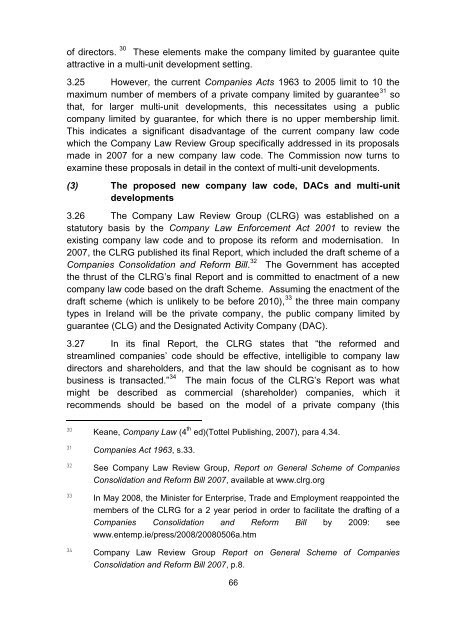Report on Multi-Unit Developments - Law Reform Commission
Report on Multi-Unit Developments - Law Reform Commission
Report on Multi-Unit Developments - Law Reform Commission
Create successful ePaper yourself
Turn your PDF publications into a flip-book with our unique Google optimized e-Paper software.
of directors. 30 These elements make the company limited by guarantee quite<br />
attractive in a multi-unit development setting.<br />
3.25 However, the current Companies Acts 1963 to 2005 limit to 10 the<br />
maximum number of members of a private company limited by guarantee 31 so<br />
that, for larger multi-unit developments, this necessitates using a public<br />
company limited by guarantee, for which there is no upper membership limit.<br />
This indicates a significant disadvantage of the current company law code<br />
which the Company <strong>Law</strong> Review Group specifically addressed in its proposals<br />
made in 2007 for a new company law code. The Commissi<strong>on</strong> now turns to<br />
examine these proposals in detail in the c<strong>on</strong>text of multi-unit developments.<br />
(3) The proposed new company law code, DACs and multi-unit<br />
developments<br />
3.26 The Company <strong>Law</strong> Review Group (CLRG) was established <strong>on</strong> a<br />
statutory basis by the Company <strong>Law</strong> Enforcement Act 2001 to review the<br />
existing company law code and to propose its reform and modernisati<strong>on</strong>. In<br />
2007, the CLRG published its final <str<strong>on</strong>g>Report</str<strong>on</strong>g>, which included the draft scheme of a<br />
Companies C<strong>on</strong>solidati<strong>on</strong> and <strong>Reform</strong> Bill. 32 The Government has accepted<br />
the thrust of the CLRG‘s final <str<strong>on</strong>g>Report</str<strong>on</strong>g> and is committed to enactment of a new<br />
company law code based <strong>on</strong> the draft Scheme. Assuming the enactment of the<br />
draft scheme (which is unlikely to be before 2010), 33 the three main company<br />
types in Ireland will be the private company, the public company limited by<br />
guarantee (CLG) and the Designated Activity Company (DAC).<br />
3.27 In its final <str<strong>on</strong>g>Report</str<strong>on</strong>g>, the CLRG states that ―the reformed and<br />
streamlined companies‘ code should be effective, intelligible to company law<br />
directors and shareholders, and that the law should be cognisant as to how<br />
business is transacted.‖ 34 The main focus of the CLRG‘s <str<strong>on</strong>g>Report</str<strong>on</strong>g> was what<br />
might be described as commercial (shareholder) companies, which it<br />
recommends should be based <strong>on</strong> the model of a private company (this<br />
30<br />
Keane, Company <strong>Law</strong> (4 th ed)(Tottel Publishing, 2007), para 4.34.<br />
31<br />
Companies Act 1963, s.33.<br />
32<br />
See Company <strong>Law</strong> Review Group, <str<strong>on</strong>g>Report</str<strong>on</strong>g> <strong>on</strong> General Scheme of Companies<br />
C<strong>on</strong>solidati<strong>on</strong> and <strong>Reform</strong> Bill 2007, available at www.clrg.org<br />
33<br />
In May 2008, the Minister for Enterprise, Trade and Employment reappointed the<br />
members of the CLRG for a 2 year period in order to facilitate the drafting of a<br />
Companies C<strong>on</strong>solidati<strong>on</strong> and <strong>Reform</strong> Bill by 2009: see<br />
www.entemp.ie/press/2008/20080506a.htm<br />
34<br />
Company <strong>Law</strong> Review Group <str<strong>on</strong>g>Report</str<strong>on</strong>g> <strong>on</strong> General Scheme of Companies<br />
C<strong>on</strong>solidati<strong>on</strong> and <strong>Reform</strong> Bill 2007, p.8.<br />
66

















